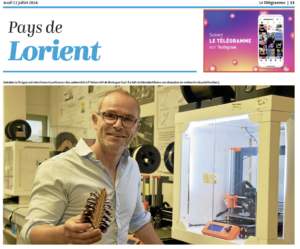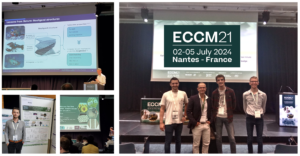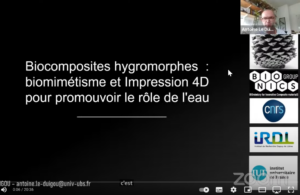Over thousands of years of evolution, biological systems have developed various strategies enabling them to feed, reproduce, defend themselves and so on. These include hygromorphic structures, which are capable of generating drive through natural variations in relative humidity, with the aim of efficiently disseminating their seeds. The actuation of these structures is directly programmed by the architecture of the materials of which they are made. They are truly passive and autonomous actuators!
These biological structures have inspired the development of new smart materials, Hygromorphic BioComposites (HBC), which are also capable of being activated by variations in ambient humidity. The response of an HBC can be programmed by controlling its architecture. Unlike the usual process for shaping composites, 3D printing of continuous filament allows great flexibility in the design of structures, with the possibility of precisely controlling the distribution of materials and the orientation of the fibres.
To highlight the design possibilities offered by 3D printing, a hygromorphic structure made from a single continuous filament reinforced with flax fibre was printed. Inspired by origami with curved folds, this structure is capable of moving autonomously under the effect of humidity, to change from a flat shape to a dome-like 3D form. This is what is called 4D printing!
PhD Work by Melvin Josselin, funded by AID / Bionics by IRDL. Supervisor Pr A. Le Duigou
French Version:
Au cours de milliers d’années d’évolution, les systèmes biologiques ont développé divers stratégies leur permettant de se nourrir, se reproduire, se défendre, etc.. Parmi elle se distinguent les structures hygromorphes, capable de générer de l’actionnement grâce aux variations naturelles d’humidité relative, dans le but de disséminer efficacement leurs graines. L’actionnement de ces structures est directement programmé par l’architecture des matériaux qui les constituent. Ce sont de véritables actionneurs passifs et autonomes !
Ces structures biologiques ont inspiré le développement de nouveaux matériaux intelligents, les BioComposites Hygromorphes (HBC), également capables de s’actionner sous l’effet de variation d’humidité environnante. Il est possible de programmer la réponse d’un HBC en contrôlant l’architecture qui lui est donné. Contrairement au procédé de mise en forme habituelle des composites, l’impression 3D de filament continu permet en grande flexibilité dans le design de structure avec notamment la possibilité de contrôler précisément la distribution de matériaux ainsi que l’orientation des fibres.
De façon à mettre en évidence les possibilités de conception offertes par l’impression 3D, une structure hygromorphe constituée d’un seul filament continu renforcé par de la fibre de lin est imprimée. Inspirée des origamis à pliures courbes, cette structure est capables de s’actionner de façon autonome sous l’effet de l’humidité, pour passer d’une forme plane à une forme 3D en dôme. C’est ce qu’on appelle l’impression 4D !








